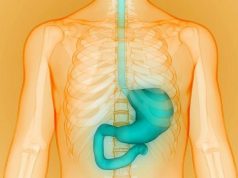GI symptoms were more prevalent in later stages of epidemic in China
FRIDAY, April 3, 2020 (HealthDay News) — Gastrointestinal symptoms are common in patients with coronavirus disease 2019 (COVID-19), with increased prevalence seen in the later stages of the epidemic in China, according to a review published online March 29 in Alimentary Pharmacology & Therapeutics.
Yuan Tian, from the Peking University First Hospital in Beijing, and colleagues reviewed gastrointestinal features of and fecal test results in COVID-19 from case reports and retrospective clinical studies relating to the digestive system.
The researchers found that the incidence of gastrointestinal symptoms was 3 to 79 percent, and these symptoms included anorexia (39.9 to 50.2 percent), diarrhea (2 to 49.5 percent), vomiting (3.6 to 66.7 percent), nausea (1 to 29.4 percent), abdominal pain (2.2 to 6.0 percent), and gastrointestinal bleeding (4 to 13.7 percent). The most common gastrointestinal symptom in children and adults was diarrhea, with a mean duration of 4.1 ± 2.5 days, which was seen before and after diagnosis. Adults and children can present with digestive symptoms without respiratory symptoms. A higher incidence of digestive manifestations was seen in the later versus the early stage of the epidemic in China. Polymerase chain reaction (PCR) testing was as accurate from fecal specimens as from respiratory specimens. Fecal PCR became positive two to five days later than sputum in 36 to 53 percent of patients. In 23 to 82 percent of patients, fecal excretion persisted after sputum excretion for one to 11 days.
“More clinical and experimental data about virus viability in feces and varying environmental conditions such as temperature and relative humidity are needed,” the authors write.
Copyright © 2020 HealthDay. All rights reserved.








